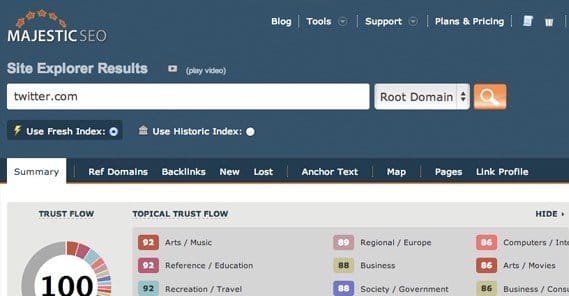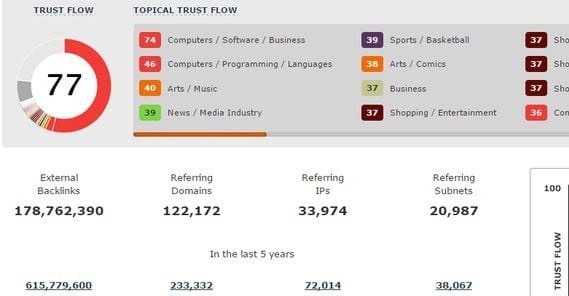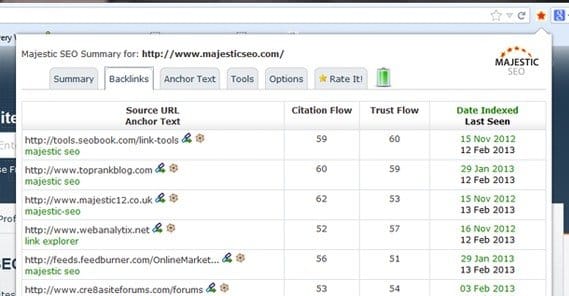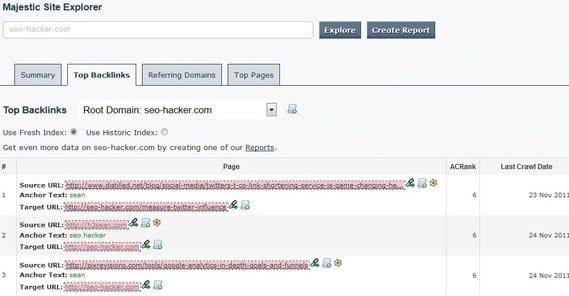What Is Majestic Trust Flow and How Do I Improve It?

A few years ago, Google was king with the metric everyone wanted to monitor and improve. That metric was PageRank, and it was as close to a direct indicator of search engine success as it was possible to squeeze out of Google. Since then, though, Google has put a damper on the idea of a metric you can monitor and improve with a direct relationship to search ranking. They want you to improve your site in many ways, not just in a few fixed ways that raise a number without necessarily improving your site.
As a response, Google stopped updating PageRank. The most recent three updates made to PageRank happened on the 7th of November, 2012, the 4th of Feburary, 2013, and the 5th of December, 2013. It is now late December in 2015, meaning it has been two full years since the last PageRank update. Face it, everyone; PageRank is dead.
This post isn’t about PageRank, though. I just bring it up to set the stage. Several years back, around 2012, other sites started making their own versions of singular metrics a webmaster could monitor as a sign of the health and performance of their site. One of these was Moz’s set of rankings, Domain Authority and Page Authority. These are great, but they’re also not the focus of our attention today. The real focus is Majestic SEO’s Trust Flow.
Majestic SEO’s Trust Flow
Majestic actually has a few interrelated metrics here. Trust Flow, Citation Flow, and Topical Trust Flow are all similar in how they’re measured and put together, based on Majestic’s proprietary analysis of the web. We’ll focus on Trust Flow for now.
Trust Flow is a measurement of the quality of an incoming link, based on the quality of links pointing to that linking site. A site with a lot of quality coming in will pass a lot of quality onwards. A site with very little quality coming in will not have much value attached to its link. This operates independently of volume, which is what really makes it special.
Why is this important? It makes it a lot harder to game the system. You can spend hundreds of hours running apps to generate backlinks for your site, sending thousands of them all at a filter site, which in turn links to your money site. According to Trust Flow, that link to your money site won’t have much value, because there’s not a lot of value coming in to that site. One single link from an authority site like Moz, a .gov, or another industry giant will be far more valuable than all the hundreds of links behind the other example.
By contrast, Citation Flow is the measurement of volume of links, independent of trust. A page with 100 links from various domains will have a higher Citation Flow rating than a site with only 10 incoming links. It doesn’t matter if the 100 links are from brand new WordPress sites and the 10 links are from big name blogs; citation flow counts volume as a priority. Except, that’s not strictly true. Citation Flow isn’t just a measure of the incoming links to your site; it’s a measure of the incoming links to the sites linking to you, and the sites linking to those sites, and on and on.
That’s why a single link from a site like Moz will give you a ton of Citation Flow value as well as Trust Flow. There are thousands and thousands of sites linking to Moz, and so any link they publish has signification Citation Flow weight behind it.
If you want to vastly simplify things, you could say that Citation Flow is a measurement of potential second and third degree connections and thus traffic, whereas Trust Flow is a measurement of perceived value, and thus is a better indicator of search engine performance.
Citation Flow is a lot like the old PageRank in this way, as it’s also susceptible to link spam, whereas Trust Flow is a lot more like a modern incarnation, which measures value rather than an exploitable metric.
Don’t think I forgot about Topical Trust Flow, by the way. It’s just Trust Flow, but it adds a filter for general topic category. Essentially, it weights links not just by their overall value, but by their value in relation to one another. Moz linking out to a car blog won’t be a great link, because Moz isn’t a site dealing with cars. It’s a way of cutting out irrelevant links.
Monitoring Trust Flow
Reasonably enough, if you want to check into the Trust Flow, Citation Flow, or another metric measured by Majestic, all you have to do is go to the Majestic website. Once there, plug in the URL of the page you want to analyze. Use the fresh index for the most accurate data. Majestic updates their index daily, to keep data accurate.
When you load up the metric, you will see a measurement of both Trust Flow and Citation Flow at the top. You will see a number of external backlinks, referring domains, referring IPs, and referring subnets – all measurements of the uniqueness of the links pointing at your site. You get a graph of where your backlinks show up on a chart with the X and Y axes measuring both Trust and Citation Flow. Information goes from there; you can check it out yourself.
In addition, you can check various sites by using the Majestic extensions for both Chrome and Firefox. These show you a limited version of the data shown by the Majestic site itself, with the option to click through to more detailed analytics.
If you want to compare more than one site at a time, you can use the Bulk Link Checker tool, found here. Additionally, various third party tools will use the Majestic API to pull their data. One such tool is Raven Tools.
If you would like to compare Moz’s Domain Authority and Majestic’s Trust Flow, you can certainly do that. Just be aware that the two of them have very similar data sources and measure much the same thing, so the data will be similar. You can see a detailed statistical analysis of both in comparison here. In general, though, Majestic is the better metric to use as a direct predictor of search engine ranking.
Ways to Use Trust Flow
The obvious way to use the Trust Flow measurement is just as an indicator of your own success. As mentioned, Trust Flow has been proven to be one of the most accurate single metrics to measure site quality, relevance, and performance in a way that can be correlated to search engine ranking. In other words, actions that improve your Trust Flow will also improve your search engine ranking, more reliably than actions that improve metrics like Domain Authority or the defunct PageRank.
Still, that’s just one self-centered way to use Trust Flow. You can do a whole lot more with it. For example…
You can use Trust Flow for competitive intelligence gathering. Come up with a keyword you want to rank for and run a search for it. With the Open Site Explorer overlay, export the search results to a file. Copy the list of specific URLs from that file and go to Majestic. Go to tools, click the link map tools, and click the bulk backlink analysis. Paste in your links and click to download data. Delete the data that you don’t need for this comparison, and create a filter to sort your data by relevance. Order the data by Trust Flow and you’ll have a list of the most relevant links to your competition. This gives you a list of targets for outreach and link acquisition.
You can use Trust Flow to help you recover from a link penalty. Both Trust Flow and Topical Trust Flow are important here. Both, when low, mean the links are at best doing nothing for you. At worst, they are actively hurting you. Essentially, the process works like this. First, run your site through Majestic to get an analysis of your links. Second, find any link that is irrelevant according to Topical Trust Flow and any link that has a low – generally sub-10 – Trust Flow. Third, follow a typical process of your choice for removing those links. Whether this means outreach, cease and desist letters, or disavowal is up to you.
You can use Trust Flow for link prospecting. Whenever you find an opportunity to guest post or to submit your site to a directory, or to buy an expired domain, or generally anything, throw the link through Majestic. Use the bulk backlinks tool to find other sites linking to those sites, and go on through the chain to find more and more potential opportunities.
There are also a bunch more advanced ways to use Majestic, from searching for Twitter profiles to filtering out ads and more. Some of them have been detailed here.
Boosting Trust Flow
If Trust Flow is the best indicator of search engine success, you obviously want to take steps to increase it. I’ve come up with a bit of a process you can use. Essentially, this is all about building authoritative backlinks. Majestic follows much the same set of rules as Google – which makes sense for it to be so accurate – which means spam links are bad, authoritative domains are good, and nofollow links pass nothing.
Identify an Industry Influencer
This step is all about finding a seed, though you have the “fringe” benefit of using them to get you an authoritative link as well. How you go about this will depend on the kind of relationship you have or you want with the influencer. I like to take a personalized route. I study what it is they write about frequently, and then I figure out what sort of data, case study, guide, or ebook they would love to read. Then I produce that kind of content. Ultimate guides are great for this, as are detailed statistical analyses and infographics. All of this content has the potential to be shared by your influencer of choice. You just need to make sure of a few things before you dig in too deep.
- Make sure the influencer is actually an influencer, not an imposter. Run them through Majestic to make sure they actually have a high Trust Flow and that their Topical Trust Flow is in the niches you’re targeting.
- Make sure the content you want to produce isn’t something they’ve already covered. I couldn’t go to PPC Hero and ask them to promote my ultimate guide to PPC; they already have one, and theirs is probably better than what I would produce in this sort of self-focused link harvesting.
- Make sure you can do the topic justice. If you’re not bringing anything new to the table, you’re not going to attract their attention.
The end goal is to have a piece of content you can send to them under the guise of “hey, you’re an expert in this field, what do you think?” Send them the link and they should check it out. If it’s good enough, it will inspire them to create content that cites it, or at least it will sit as something they can link to as an illustrative point in a future piece they create.
Analyze Your Influencer to Find More Influencers
While you’re working to earn a link with your chosen influencer, you should also run them through the Majestic backlink checker to find the most influential sites that are linking to that influencer. After all, no high profile site got to where it was without the support of other high profile sites. The industry community is very much that; a community. People know each other, and even if their companies compete for the same niche, they can still treat each other with respect.
The goal here is to find other influencers you can target in the same way that you’re targeting the first. In many cases, the content you’re producing for one influencer in the niche will work for the same purpose for another influencer. That’s great! You’re killing two birds with one stone. However, for a more personal touch, you can create direct response content. Pick a controversial post the influencer has made recently, then write a post that argues for the other side of the coin. Even if you eventually end up agreeing with them, the controversy might be something they want to address, and they might link to the post when they do. Just try not to be so antagonistic that you fall into the “a notable blogger contested my opinion, so I’m going to not name names and just indirectly reference them” zone.
Search Out Guest Posting Opportunities
There’s a well-defined way to find guest posting openings around the web these days, and it works for SEO as long as you’re not doing it in an exploitative way. I just recommend adding one more step to the process.
When you find a site that you think is promising for a guest blogging opportunity, run it through Majestic. Take a look at its actual Trust Flow rating and see if it’s as highly rated as you would like it to be. Many sites will tend to be in the 20-40 range, with sites in the 50s and 60s proving exceptional. If a site is under 10, you probably don’t want to deal with them. You won’t get much out of it.
Equally important is the ability to check if the links they allow in guest posts are followed. If the links are not followed, the guest posting opportunity won’t do a think for your Trust Flow. That’s not to say it’s worthless, of course. It builds branding, it works as a link for Citation Flow, and it gains you exposure to another audience. It just won’t improve your Trust Flow.
The lesson here is, basically, just sites, people, profiles, and groups through Majestic to check their Trust Flow so you can get an idea of how their links will impact your search ranking. The lower their Trust Flow, the less you should worry about getting followed links from them.
 ContentPowered.com
ContentPowered.com










Majestice one of the best tools for SEO and two factors one of them Trust flow and other citation flow, where to know about any websites and If get any backlinks from any website, both the value is high, its more benefits for that websites, Otherwise nice article, and Thumb’s up.. 🙂
The problem with SEO and to extension DA/PA and Trust Flow / Citation Flow is that while it is pretty easy to up them on blogs and websites it is really hard on e-commerce as you add products and descriptions, for example the website I am administrating is an orthopedics equipment e-shop. It is virtually impossible to get quality backlinks on topic, as in order to write a medical document and publish it you need to be a doctor. There are very few things that you can do, or so I have found out over time.